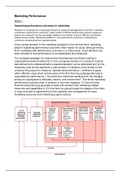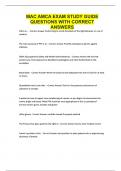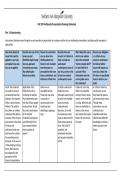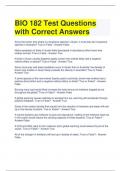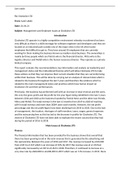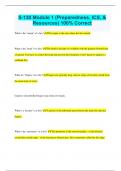Week 1
Assessing performance outcomes in marketing
Research in marketing has increasingly focused on building knowledge about how firms’ marketing
contributes to performance outcomes. Large number of different performance outcome measures
used in prior research may be only weakly related to one another, makes it difficult to synthesize
findings across studies. Significant problems in how performance outcomes in marketing are
commonly conceptualized and operationalised.
A key central question in the marketing discipline is the role that firms’ marketing
plays in explaining performance outcomes. Main reason for study: although linking
firms’ marketing with performance outcomes is a critical issue, scant attention has
been devoted to how performance is conceptualized and measured.
The accepted paradigm for measurement development and theory testing in
organizational science holds that (1) the conceptual domain of a construct must be
well-defined and understood before operationalization can be attempted and (2) the
measures used should represent a valid sample of indicators of the domain of the
construct they purport to measure. Operational performance = fulfilment of goals
within different value-chain activity areas of the firm that may subsequently lead to
organizational performance = “the economic outcomes resulting from the interplay
among an organization’s attributes, actions, and environment”. The whole marketing-
performance outcome chain is dynamic in two main respects: (1) firms reinvest
financial resources they generate to build and maintain their marketing-related
resources and capabilities & (2) firms learn by going through the stages of the chain
in ways that lead to adjustments to their selection and management of future
marketing resources and marketing program actions.
,Analysing the conceptualization and operationalizations of performance adopted in
empirical studies requires a well-defined and theoretically anchored evaluative
framework. Should consider 5 critical issues:
1. Theoretical rationale: whether performance is formally defined and conceptual
rationale provided in the conceptual part of the article. [provided / not provided]
2. Conceptual approach to treatment of performance: how the performance construct
is viewed theoretically and treated empirically. [latent construct / separate constructs /
aggregate construct]
3. Aspects of performance assessed: type of performance outcome assessed.
[customer mindset / customer behaviour / customer-level performance / product-
market performance / accounting performance / financial-market performance]
4. Referents of performance: standards against which performance is judged.
[absolute / temporal / inputs / competition-industry / firm’s goals / stock market]
5. Time horizon: temporal perspective reflected in the outcome measure. [historical /
current / future]
Results → Most widely used measures of marketing performance outcomes are
accounting indicators of profit and sales revenue and market share, which is a
product-market performance indicator. Rapid rise in interest in its financial
performance outcomes of marketing, emphasis on shareholders. Within customer
mindset aspect, customer satisfaction is the dominant measure used. Little is
empirically known about what drives brand equity and CLV. Most widely used at
product-market level is market share. Measures related to profit and sales revenue
are the two most widely used accounting performance outcome indicators. Rapid
recent rise in use of stock market-related measures of performance, driven largely by
the top three marketing journals of the last decade.
Rapid rise in interest in assessing marketing’s performance outcomes. Results
provide strongest evidence to date that any assumption of strong positive correlations
between different aspects of performance is often false. Guidelines in designing and
reporting studies: (1) avoid conceptualizing and operationalizing “performance” as a
global latent construct, (2) clearly depict the conceptualization of performance
adopted in the theoretical development of the study and provide a rationale for the
conceptualization adopted, (3) select one or more indicators from within each chosen
performance aspect to operationalize the performance conceptualization adopted, (4)
do not expect relationships between independent variables and indicators of different
aspects of performance to necessarily converge, (5) make explicit referent and time
horizon choices associated with the measures of performance outcomes employed
and provide rationale for the appropriateness of these choices, (6) theorize and
hypothesize expected cause-and-effect relationships that are specific to and tightly
connected with the particular performance aspects and indicators selected, and (7)
report sample sizes and correlations, including those between the dependent
variables measuring performance that are employed when using more than one
marketing performance indicator.
,College (9/9/2019) → Marketing is the activity, set of institutions, and processes for
creating, communicating, delivering, and exchanging offerings that have value for
customers, clients, partners, and society at large. It is about exchanging value (with
customers and other stakeholders).
Marketing performance (marketing productivity) refers to marketing productivity:
resources are employed to generate outcomes. How marketing expenditures add
value. What is the impact of marketing?! Lots of marketing metrics, such as loyalty
measures, market performance, & customer lifetime value (financial & non-financial).
Assessing Performance Outcomes in
Marketing = How does the marketing
literature deal with marketing performance?
Describing how academic people use
different performance outcomes in
marketing.
Discussion and managerial implications: (1)
many studies treat performance as a single
construct, (2) correlations between different
performance indicators are likely to be low,
and (3) how can we generalize results from
studies that use performance as a
dependent variable?
For managers: use each of the six aspects of performance & pay attention to causal
relationships between these aspects, and realize some may be negative.
Vargo and Lusch (2004) observe marketing
evolving to a ‘new dominant logic’ – the
service-dominant logic. Goods → Services.
Operand: resources on which an operation or
act is performed to produce an effect.
Operant: are employed to act on operand
resources.
When products/services are seen as
operant resources, then value is only
created in use (‘co-created’). Part of the
impact of marketing is with the ‘co-creators’.
Assessing market performance has become
much more complex.
, A multiple-layer model of market-oriented organizational culture: measurement
issues and performance outcomes.
Explicit distinction is drawn among values that support market orientation, norms for market
orientation, artifacts indicating high and low market orientation, and market-oriented behaviours.
Authors develop scales for measuring the different layers of market-oriented culture and analyse
relationships among the different components of market-oriented culture. Artifacts play a crucial role in
determining behaviour within organizations. A market-oriented culture influences financial performance
indirectly through market performance and that this relationship is stronger in highly dynamic markets.
Two perspectives on market orientation: behavioural (specific behaviours) and
cultural (more fundamental characteristics of the organisation) perspective. Purpose
of the article is to develop a broader cultural perspective of market orientation. Four
objectives: (1) develop model of market-oriented organizational culture that makes an
explicit distinction among different layers of organizational culture, (2) develop and
validate measurement instrument of market-oriented organizational culture based on
multilayer conceptualization, (3) analyse structural relationships among the different
layers of market-oriented culture, and (4) analyse performance outcomes of a
market-oriented organizational culture.
Organizational culture consists of four components: shared basic values, behavioural
norms, different types of artifacts, and behaviours. Values = conception, explicit or
implicit, distinctive of an individual or characteristic of a group, of the desirable which
influences the selection from available modes, means, and ends of action. Norms =
different from values by a higher degree of specificity and a higher relevance for
actual behaviour. Artifacts include stories, arrangements, rituals, and language that
are created by an organization and have a strong symbolic meaning. Behaviours =
organizational behavioural patterns with an instrumental function.
H1: The presence of shared basic values supporting market orientation has a positive
impact on the presence of norms for market orientation. SUPPORT


